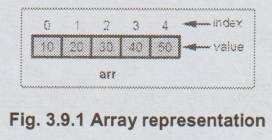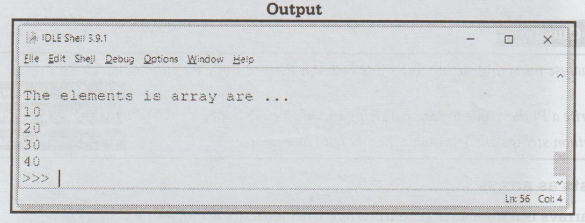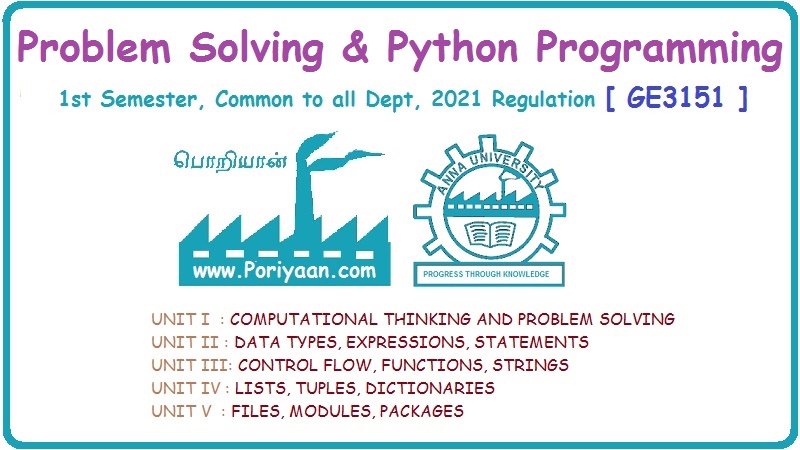Problem Solving and Python Programming: UNIT III: Control Flow, Functions, Strings
Lists as arrays
Syntax, Example Program, Creation, Operations | Python Programming
A list in Python is just an ordered collection of items which can be of any type. By comparison an array is an ordered collection of items of a single type.
Lists as arrays
The
arrays is a data structure in which the elements are of same data type.
A
list in Python is just an ordered collection of items which can be of any type.
By comparison an array is an ordered collection of items of a single
type.
The
elements in the array are separated by comma and are enclosed within the square
bracket. For example
arr
= [10,20,30,40,50]
The
arr can be represented by following figure

Fig.
3.9.1 Array representation
Here
the values are arranged sequentially as follows –
arr[0]
= 10
arr[1]
= 20
arr[2]
= 30
arr[3]
= 40
arr[4]
= 50
1. Creation of Arrays
We
can create an array using the array name and list of elements. For example
arr
= [10,20,30,40]
will
create an array containing the elements 10,20,...,40. These elements can be
represented using for loop. Following program represents the array creation and
display of elements.
ArrayDemo.py
arr
= [10,20,30,40] print("The elements is array are ...")
for
i in range(len(arr)):
print(arr[i])
Output

Another
method of creation of Array
We
can also create an array using following method
a
= [i for i in range(10)]
2. Operations on Arrays
1.
Appending a value
Using
append() function we can add the element in the array at the end. For example
ArrayDemo1.py
arr
= [10,20,30,40]
print("The
elements is array are ...")
for
i in range(len(arr)):
print(arr[i])
arr.append(50)
print("Now
The elements is array are ...")
for
i in range(len(arr)):
print(arr[i])
Output
The
elements is array are ...
10
20
30
40
Now
The elements is array are ...
10
20
30
40
50
>>>
Thus
we can see that value 50 is appended in the array.
2.
Inserting the element in the list
autemele
ed We can insert the value at any desired location using insert() function. The
syntax is insert(index,value)
For
example
ArrayDemo2.py
arr
= [10,20,30,40]
print("The
elements is array are ...")
for
i in range(len(arr)):
print(arr[i])
arr.insert(2,25)
print("Now
The elements is array are ...")
for
i in range(len(arr)):
print(arr[i])
Output
The
elements is array are ...
10
20
30
40
Now
The elements is array are ...
10
20
30
40
>>>
3.
Extending the array
We
can extend one array by joining another array to it. For that purpose the
extend() function is used. The syntax is
extend(new_array)
For
example
ArrayDemo3.py
arr
= [10,20,30,40]
print("The
elements is array are ...")
for
i in range(len(arr)):
print(arr[i])
new_arr
= [50,60,70]
arr.extend(new_arr)
for
i in range(len(arr)):
print(arr[i])
Output
The
elements is array are ...
10
20
30
40
50
60
70
>>>
4.
Removing the element from the array
Any
desired element can be deleted from the array using remove() method. The syntax
is
remove(index_of_element)
For
example
ArrayDemo4.py
arr
= [10,20,30,40]
print("The
elements is array are ...").
for
i in range(len(arr)):
print(arr[i])
arr.remove(30)
print("Now
The elements is array are ...").
for
i in range(len(arr)):
print(arr[i])
Output
The
elements is array are ...
10
20
30
40
Now
The elements is array are ...
10
20
40
>>>
5.
Removing last element from array
For
removing the last element from the array then pop() function is used.
Syntax
pop()
For
example
ArrayDemo5.py
arr
= [10,20,30,40]
print("The
elements is array are ...")
for
i in range(len(arr)):
print(arr[i])
arr.pop()
print("Now
The elements is array are ...")
for
i in range(len(arr)):
print(arr[i])
Output
The
elements is array are ...
10
20
30
40
Now
The elements is array are ...
10
20
30
>>>
6.
Reversing the elements of array
We
can reverse the contents of the array using reverse() function
For
example
ArrayDemo6.py
arr
= [10,20,30,40]
print("The
elements is array are ...")
for
i in range(len(arr)):
print(arr[i])
arr.reverse()
print("Now
The elements is array are ...")
for
i in range(len(arr)):
print(arr[i])
Output
The
elements is array are ...
10
20
30
40
Now
The elements is array are ...
40
30
20
10
>>>
7.
Counting the occurrence of element in array
We
can count the number of times the particular element appears in the array using
the count method.
For
example
ArrayDemo7.py
arr
= [10,20,30,40,50,20,30,20]
print("The
elements is array are ...")
for
i in range(len(arr)):
print(arr[i])
print("The
element 20 appears for ", arr.count(20)," times in array")
Output
The
elements is array are ...
10
20
30
40
50
20
30
20
The
element 20 appears for 3 times in array
Problem Solving and Python Programming: UNIT III: Control Flow, Functions, Strings : Tag: Engineering Python : Syntax, Example Program, Creation, Operations | Python Programming - Lists as arrays
Related Topics
Related Subjects
Problem Solving and Python Programming
GE3151 1st Semester | 2021 Regulation | 1st Semester Common to all Dept 2021 Regulation
